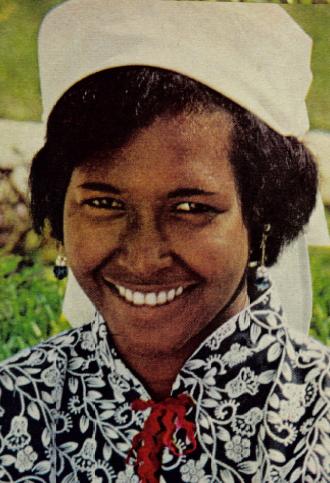Community News. For centuries, African women in southern and West African countries have worn head ties that had several different functions. Firstly, it was worn to protect the head from the sun and dust and in some communities; it was an effective means of communication that helped to promote social interaction. The way in which the head tie was fashioned, also had symbolic meanings for the wearers as well as those observing the style because it allowed people to gather information about each other by showing that individual’s role and relationship with the broader community.
Moreover, each clan or family group had its own code of nonverbal communication that was understood within a particular locality. Today, in the Yoruba culture of Nigeria, the gele is worn as a fashion accessory to compliment a woman’s dress.
Traditionally, the way the gele was tied, advertised a woman’s marital status. When the end of the gele leaned to the right side, it indicated that the woman was married and when it leaned to the left, those who understood such symbolism would know that the woman was single. The gele also displayed a woman’s social status; the higher the headdress, the more prominent that individual was within their society. One of the many visual methods of non-verbal communication that enslaved women introduced to the Caribbean and South America was conveyed through the head tie.
The anjisa, the given name for the head tie in the former Dutch colony of Suriname, continued to function in the traditional West African way as a means of communication. Only now, its messages highlighted warnings and danger in a code that the slave-masters would not have understood.
Such symbolism was used as a method of intercultural communication between different language groups. During the 1960s, the printed designs on the anjisa told stories about recent events, hence it was used as a medium for social and political commentary and like the gele, the anjisa’s message was interpreted by the way the ends were tied. Onlookers were able to identify a woman’s emotional moods in connection with her love life, social life, and her relationships with neighbours. Events such as births, deaths and marriages could be publicly displayed within the folds of the head tie. Today in Suriname and Holland, African-Surinamese women wear the anjisa casually and for special occasions.
In Saint Lucia, a similar method of non-verbal communication re-emerged. Unlike slavery on British owned territories, the French, under the Code Noir, permitted enslaved people to marry after conversion to Catholicism. On the plantations, movements and methods of communication were severely restricted for enslaved people because the slave-owners were afraid that they would plot and revolt.
However, because enslaved Africans had a cultural point of reference before enslavement, similar methods of non-verbal communication re-surfaced to convey messages. Those messages played an important role in their courtship procedures. Through those methods, women announced their availability for courtship and marriage.
The traditional Saint Lucian headdress, the Tête en L’air (literally, the head in the air) allowed onlookers to know a woman’s marital status or availability for a relationship. The head tie was folded in such a way that it could form multiple peaks with the material. A head tie with one peak meant that the wearer was single and would be willing to enter into a relationship. A head tie with two peaks indicated that the wearer was a married woman. Three peaks indicated that the woman’s husband had died and a four-peak head tie indicated that the woman was desperate to marry and would consider anyone who propositioned her. Nowadays the Tête en L’air is worn for ceremonial purposes during quadrille dance performances and the same type of dress make up the Saint Lucian national costume.






